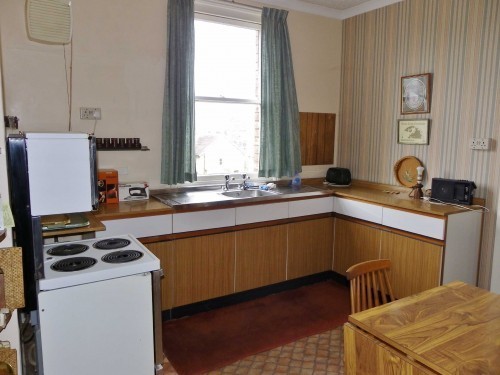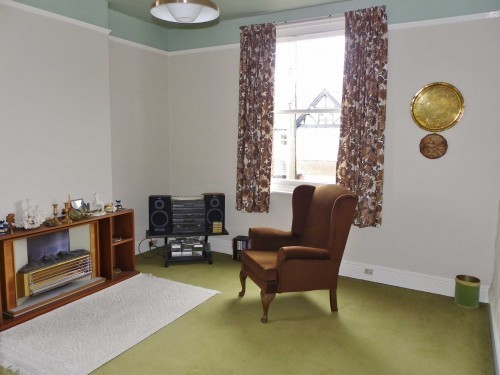From house to home, Part 1 – guest post by rachel
Last spring, the chap that I’d been seeing for five years and I decided to throw our lots in together. My lot includes a teenage daughter, a ginger cat and a small house. His lot included four large (mostly adult) sons, and a partially remodeled house in a place I didn’t want to live.
He is a jack of all trades. He can build, plaster and plumb. “Wonderful” I hear you cry “How fortunate you are”. Well, yes and no. The first problem is that he is a perfectionist, and has been known to remove someone else’s brick-laying and redo it to his own standards. This can occupy a great deal of time. The second problem is that because he can do it himself, he doesn’t like paying other people to do it. This may also take up a lot of time.
Anyway, we found a house that we could afford on my salary (the income of perfectionist builders being not as reliably high as you might hope) which we could afford because it had been lived in by an elderly lady and had no central heating.
Here is what the kitchen used to look like.

What you cannot see in this picture is the vinyl covered boarding behind the table, which conceals a vertiginous ladder leading down to the basement. Sadly I did not take a photo of this.
My PB (perfectionist builder) and I had enormous pleasure in sketching out redesigns. We could knock the wall through (the stripey one) into the room next door and create a fabulous kitchen diner.
This is what the room next door used to look like.

We could change the ladder down from the kitchen into some proper stairs and turn the basement into a wonderful workroom. Or perhaps even a small flat for one of the adult children.
We could put in a wood burner and a new chimney.
We could add solar heating to the roof.
We could…
Well. We bought the house. And PB went in and knocked the vinyl covered cladding down. And discovered that the existing electric wiring was copper encased in perished rubber and wrapped in lead. His first action therefore was to turn off all power to the house until he’d re-wired it.
Then he knocked down the wall between the two rooms and put in a supporting RSJ (I believe that stands for rolled steel joist). Inserting the RSJ took three large men and me. Two of the men were well over six foot tall. One of them was standing on the floor holding the RSJ up with his fingertips while it slid into place. The other stood on the scaffolding and bent down to the job. I provided the soundtrack, inserting “Ah!” and “Oo-er!” at appropriate intervals.
(To be fair, I did help carry it over the garden wall and into the house. I supported an end.)
Here is a warning to anyone who is planning to have a wall knocked through. It is surprisingly quick to knock a wall down and insert a joist if everything has been properly prepared. You get an immediate sense of achievement and a sense that things are really cracking along and the job will be finished quite quickly. It can take a very, very, very long time after that for the RSJ to be boxed, plastered and painted. For the damaged lath and plaster ceiling to be replaced with plasterboard, skimmed and painted. This of course, includes the time for the woodworm revealed in the newly exposed joists to be treated and many discussions as to the purpose of the odd bricks that were found in the gaps between the joists.
The next thing that happened was the digging out of the basement to put in the new stairs. We had hoped that there would not be much to dig out. In fact, there was quite a lot. Fortunately PB’s youngest son was persuaded that he could earn a reasonable wage by labouring over the summer before leaving for university. He dug. And nipped home to make coffee and check Facebook. And shovelled. And nipped home to play a quick half hour of an online computer game with his mates. And dug and shovelled and wheelbarrowed. And had a break to check his email.
Before he could even start on the digging, he had to remove the vinyl lining that had been applied to the basement walls to prevent damp. It hadn’t prevented it. It had contained it. The damp was flourishing behind the cladding, and beginning to creep out, rotting any timbers which touched it.
This photo shows the mound of rubble that was removed from where the stairs are going to be.
The dark patch on the wall to the left is the amount that used to be underground. The gap in the floorboards on the right is the space where the old stairs used to be.
All the work had to be done around the large hole in the floor. PB, being over six foot, could still get down into the basement without stairs. I could not.
You can also note the long orange extension cable that leads from the basement: the only safe electricity supply in the house.
We are planning a house warming party in a fortnight.
Robin McKinley's Blog
- Robin McKinley's profile
- 7240 followers



